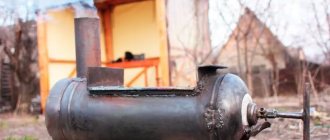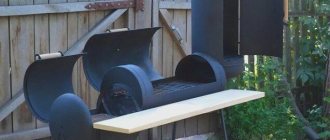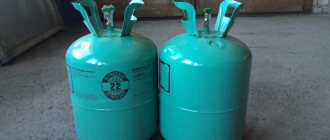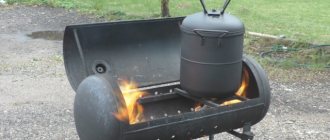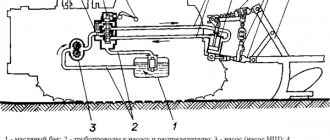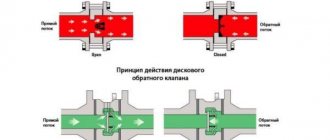Glassblowing workshop equipment. Increasing the receiver capacity of a factory compressor
Continuing the theme of equipping a glassblowing workplace in a workshop, one of the main elements for glassblowing work is a special burner. It has certain requirements, among the first is a stable flame. The burner is powered by a mixture of combustible gas, and its components most often include air. It is clear that an even, constant flow over time is required.
In the old clay times, air was compressed to supply it to the burner using bellows. Surely today, “When spaceships plow the Bolshoi Theater,” you can find small gasoline burners, like jewelry or dental ones, with bellows. This makes sense for portable devices - light weight, non-volatile. Sometimes, in laboratory conditions, a water jet pump is used to obtain air compressed to low pressure.
For tabletop burners, in particular those used by glassblowers, electric blowers - compressors - are now used. Operational requirements for blowers by master glassblowers - near the burner, the compressed air must be under pressure that is 100...150 mmHg above atmospheric pressure. Air must be supplied evenly and without interruption - stopping the air supply at a critical moment of operation can lead to the destruction of a valuable product. If you work with a carburetor, there is a risk of flame leaking into the carburetor and a fire is possible.
At first, to experiment with a glass-blowing burner using gasoline vapor, I used a homemade compressor from a refrigerator. It turned out, however, that it has to be turned on quite often, ideally working almost continuously. In this case, the pressure will be most stable. In this mode, a dehumidifier in the form of a box-can with silica gel should be installed on the air intake. Otherwise, moisture from the air will accumulate inside the compressor in the oil. One of the design features of refrigerator compressors is that the open electric motor floats in oil. The accumulating water will sink to the bottom and can easily cause a short circuit in the windings.
Significantly more compressor. Its 24-liter receiver ensures fairly long operation between starts, making it more convenient to work. In addition, the compressor has a classic layout - a separate piston group, a separate motor - like nuts and cutlets in the saying, and there are no worries with drying the incoming air. Factory settings of the pressure switch allow the compressor to automatically pump up the capacity to 7 atmospheres, then the consumer disassembles it through an adjustable reducer. The very small pressure required for the burner to operate allows the compressor to turn on quite rarely - once every few tens of minutes, depending on the power of the burner. However, each start-up adds a few gray hairs to an unbalanced person - the compressor is quite noisy. You sit in silence - only the flame of the burner slightly hisses, in your hands there are shaped pieces of glass - a kind of frozen music, trembling in your soul... And suddenly behind your back - DRRRRRRRRRRRR. Oh my mother-soviet-woman. Here even a Zen master will jump, that same one and a half meters.
Of course, the most radical way would be to remove the noisy unit into a separate room; in fact, this is what they do in large workshops. What would you order grandfather Mazai to do in his own space, which represents a single space? Of course, you can also think in this direction, but for now, as a compromise option, you can in a simple way reduce the number of compressor operations by increasing its receiver.
Generally speaking, compressors of this type (piston, “construction”), with the same compressor but different receiver capacities, can differ significantly in cost. This is apparently connected not so much with the cost of steel used for the cylinder, but with the weight and dimensions of the device and, accordingly, the cost of transportation and storage.
During operation, a compressor with a small receiver is good for relatively mobile use, where its modest dimensions allow for convenient movement, this can be powering a pneumatic tool in a farmstead or painting, when the length of the existing hoses may not be enough and it is more convenient to move, transport the unit to the place of use . For stationary use, for similar tasks, it would be better to have a larger receiver capacity. However, in the mentioned subsidiary farming, both types of tasks may arise. Let's say, in the cold season - stationary use in the workshop, with the onset of the warm, “construction and field” season, relatively mobile. For example, if the outside temperature is sufficient, it is more convenient to paint outside, and so on. In this case, it would be convenient to have a variable volume of the receiver - increased at a permanent place, even if it would be more cumbersome, "in the field" - a standard one. A solution suggests itself with a detachable connection to the original cylinder, another container.
This is exactly what was done. As an additional receiver, a household gas cylinder for propane with a capacity of 27 liters was chosen. After some reorganization of its gas industry, it remained “on the siding”. It was decided, if possible, not to make changes to its design so that, if necessary, it could be used for its main purpose. For this purpose, standard connecting parts from failed gas appliances were used. Also, it would be convenient to use standard spiral plastic hoses with quick-release connectors that automatically lock the channel. This will allow you to flexibly change the equipment configuration. For example, you can use a longer hose, connect several of them, install a cylinder of a different capacity, several pieces through standard “tees”, and so on. By the way, if necessary, you can pump compressed air into the cylinder, for example, to use it in a place where there is no electricity.
So. What was used in the work.
Tools, equipment.
Structural soldering was used - you need a small gas torch with the appropriate solder and flux. Something for drilling, a set of ordinary metalwork tools.
Materials.
In addition to the most experimental compressor and a gas cylinder, we needed standard pneumatic connectors, FUM tape, solder No. 3 and a paste-like flux for it - from a copper water supply. Standard connection fitting to a gas cylinder.
After some deliberation, the plug on the tee was chosen as the location for connecting the additional container. A standard quick-locking pneumatic “mother” will be installed on it. Among other things, this will allow you to disconnect and connect an additional receiver at any time, including under pressure, without loss of compressed air.
A set of standard fittings was purchased on AliExpress. “Mother” with internal thread. You cannot solder it directly - you can damage the rubber seals inside, and disassembling it is not so easy. It was decided to use one of several “dads” (Swedish family?) with the same thread as a transitional part. It doesn't have any rubber bands - you can safely solder it.
After unscrewing the plug on the compressor, it turned out that this was not a tee, but, naturally, a check valve. However, this does not change the matter, you just need to make sure that the soldered “male” does not stick out too much inward and does not interfere with the normal operation of the valve. The silicone gasket and the attached spring with an elastic band were removed from the plug. The center was found, a small hole was punched and drilled and bored out with a needle file and then a file to the required diameter. The “male” was shortened with a hacksaw, the soldering points were cleaned. Flux, soldering, washing off flux residues with warm water, reassembly. Installation of the “mother” on the FUM tape, testing with operating pressure.
To connect a gas cylinder to the system without modifications, you will have to use standard connecting parts. They were obtained from a failed household gas reducer. The fitting was modified to fit tightly with the “male” from the kit. A small file. Well, as usual - clean the soldering areas, flux, solder, wash off the residue. Yes, do not forget to put on the union nut before soldering - it cannot be removed from the finished soldered adapter - the turnkey edges get in the way, this is not bad, it will not get lost during operation.
Making a 220 V electric air compressor with your own hands
Making a compressor with your own hands is easier than it seems at first glance. Let's look at the basic principles of how to make a compressor step by step.
Necessary materials
Properly preparing materials is half the job of assembling a compressor unit successfully completed. To create a classic device operating from a 220 V network you will need:
- pressure gauge,
- pressure control relay,
- gearbox with built-in oil and moisture protection filter,
- gasoline engine cleaning filter,
- crosspiece for water with internal thread,
- thread adapters,
- clamps or ties,
Making an electric air compressor with your own hands
- engine,
- receiver,
- engine oil,
- switch for working with voltage 220 V,
- brass tubes,
- hose made of oil-resistant material,
- board,
- medical syringe,
- corrosion inhibitor,
- washers, nuts and studs,
- means for creating hermetic connections,
- auto enamel,
- file,
- small wheels from toy cars or furniture,
- motor filter from a diesel engine.
Assembling the engine
First, let's prepare the motor. Its role is to pump up air pressure. In order not to buy a special motor, you can use a motor from an old refrigerator.
Motor from an old refrigerator for making a compressor
The power unit contains a relay; it is useful for maintaining the selected pressure value in the system. Professionals note that Soviet refrigerators were equipped with more efficient motors; they are suitable for creating a compressor of greater power in comparison with imported products.
First of all, remove the motor from the refrigerator. To make it usable, the case will have to be cleaned. It is important to use a detergent that will prevent oxidation and corrosion. After cleaning the surface, the motor is suitable for painting.
Assembling a homemade compressor:
- The motor contains 3 tubes: 1 sealed and 2 open for air circulation. Determination of the output and input channel is required: the easiest way to find out about the role of the tubes is to turn on the motor.
- After external treatment, the oil must be changed. The best choice is a semi-synthetic product, which has the same characteristics as a motor product and contains various useful components. To replace it, a plugged tube is used, the end of which is cut off with a file. It is important to prevent sawdust from entering the system, therefore, after making a cut, you need to break the tube and introduce new oil with a syringe.
- It is important to properly close the oil filling channel to prevent leakage. A screw with the appropriate cross-section is selected and fum tape is applied to it. A sealant will come in handy during this process. The bolt is screwed tightly into the pipe.
- The motor and relay are mounted on a thick base board. The sensitivity of the relay requires maintaining the angle of the motor that was present in the refrigerator. Additionally, the engine is marked with the recommended position of the housing for stable and proper operation.
Compressed air reservoir
The air tank is an integral component of the compressor, without which the installation will not work. When choosing a tank, it is important to consider the amount of pressure that the cylinder can withstand (indicated on the body). An alternative option would be to use a receiver, old containers from a 10-liter fire extinguisher, since these containers are sealed and quite reliable.
Read also: How to make an ovoscope with your own hands in 5 minutes? Step-by-step instructions, recommendations
The air tank is an integral component of the compressor, without which the installation will not work.
The start valve is replaced with a threaded adapter, which is screwed onto the receiver. Creating a tight connection will ensure the use of fum tape.
If there are pockets of corrosion on the receiver, it must first be cleaned with sandpaper or a grinding machine. To remove rust from the inside, pour a special product into the container and mix thoroughly. Next, install a cross adapter of the plumbing type; it is mounted using sealant.
Assembling the device
Final assembly is carried out in stages:
- The prepared receiver and motor are attached to a thick board. For fixation to the base, washers, nuts and studs are used. The location of the tank is strictly vertical. A reliable connection will be ensured by 3 sheets of plywood, on one of which a hole is cut for inserting a container. The remaining sheets are attached to the wood and plywood receiver retainer. From the floor side, furniture wheels are welded to the bottom for ease of movement.
- A rubber hose is placed on the air capture tube, to which a cleaning filter from a gasoline engine is attached. Separate clamps for attaching the filter are not required, because the inlet pressure is low.
- To prevent oil and water particles from entering the working composition, an oil and moisture separating filter from a diesel engine is installed on the outlet tube. Due to the relatively high pressure in the wire, it is recommended to use auxiliary fasteners; screw clamps are suitable.
- A cleaning filter is installed at the inlet of the gearbox; it is required to create a decoupling and direct air movement. The connection is made with a plumbing cross on both sides. A pressure switch or pressure gauge is installed on the opposite side to monitor and regulate the pressure level in the receiver. An adjustment relay is installed on top of the cross. All elements are mounted hermetically.
Materials for assembling a homemade compressor
- By means of regulating pressure, intermittent operation of the homemade structure is ensured. To adjust the relay, they act on 2 springs: one to set the maximum pressure, and the second to set the minimum.
- The electrical circuit contact is connected to the supercharger, and the second is connected to the minus phase. The second wire is connected to the supercharger via a toggle switch and to the mains phase. The toggle switch acts as a start button to activate and deactivate the device without removing the plug. All contacts are connected by soldering and then insulated.
- Painting of metal structures.
After creating the compressor, all that remains is to check its performance.
Testing and setting up a homemade compressor for painting cars
Having made a powerful compressor with your own hands, you should connect the spray gun to it.
- Set the toggle switch to the inactive position, connect the plug to the electrical circuit.
- Initially set the relay to a low value and start the installation. Monitor work using pressure gauge readings. Now the user should make sure that the relay is working properly; it should open the circuit when the indicators are exceeded.
- To check for leaks, use a soap solution to wet all connections.
- Now the spray gun is turned on to release the air from the container. If the system is working properly, after the pressure drops the device should turn on.
If the device has passed all stages of testing, it is recommended to test the device in action by trying to paint a body element. The greatest attention is paid to the quality of the layer and composition, as well as stability of operation.
Testing and setting up a homemade compressor for painting cars
Design
The air intake consists of many elements, the main ones include the following:
- pressure gauge that controls the pressure level;
- sealed container for compressed air;
- pipes connecting the device to the pneumatic system and compressor;
- a safety valve that allows the media to be released at elevated pressure;
- faucet for removing moisture.
Selection of a receiver for a compressor is necessary only for piston units. Plate or screw based devices do not require the use of such additions. Under the influence of pressure, the working medium is delivered into the container using a pipe and reaches the required pressure level. In this case, condensation forms and the overall air humidity decreases. Compressed gas is supplied to a pneumatic tool or pneumatic system through the outlet pipe.
Why do you need a receiver in a compressor?
A receiver is a container for storing liquids or gases during compressor operation. The device performs the following tasks:
Compressor device - diagram
- Accumulates the working mixture during compressor operation.
- Delivers compressed air to one or several consumers.
- Regulates the pressure of the working mixture at the outlet of the compressor.
- Accumulates and removes condensate that forms.
- Helps reduce vibration, noise and load during compressor operation.
The compressor receiver is made of high strength material. To store liquid and gaseous substances under a load of up to 2.0 atmospheres, containers made of high-strength plastic and rubber are used.
To store substances under a load of over 2.0 atmospheres, metal containers are used. The material used for them is steel with the addition of special additives. These additives increase the strength, anti-corrosion and thermal resistance of steel.
Purpose of air receivers
A high-quality air collector literally allows you to create a laminar flow of forced air by accumulating excess air in a reserve tank. But due to their design features, compressed air receivers also perform many side functions:
- Partially clean the air mixture from oil and excess moisture;
- They create a reserve of compressed air in the circuit in case of interruptions in the operation of the complex or in the event of a sharp increase in the needs of the system;
- By ensuring uniform operation of the industrial compressor, the air collector also helps reduce the number of engine starts of the installation.
- Reduces the load on the compressor inlet valve by reducing suction cycles.
Thus, air collectors for the compressor stabilize the working process, extend the service life of the complex, save resources, and also eliminate the occurrence of emergency situations.
Functions
The compressor receiver is designed to prevent the formation of corrosion in the system by removing excess moisture. It is also capable of storing compressed air and ensuring continuous operation during increased loads. Therefore, it becomes indispensable when the productivity of the units is insufficient and the functioning of a large number of consumers.
Equipment operating in automated mode is switched on when the pressure drops to a given level and switched off when it rises. The receiver reduces the number of cycles, which increases the period of uninterrupted operation and reduces wear. The supply of compressed air is uneven due to the specific functioning of piston systems. This problem is eliminated by a special air accumulator that prevents pulsation.
How to choose the optimal receiver parameters
The selection of the most suitable receiver is carried out according to the main parameters. The most important is the volume, which depends on the following points:
- Installation performance. In this case, a gas cylinder with a capacity of 25 liters is sufficient.
- Cyclicity of compressed air consumption. This indicator is characterized by how many times the installation has to be turned on and off.
Before using the gas cylinder directly, you should pay attention to its integrity. The presence of even minor defects determines that the device cannot be used. The test is carried out by filling the container with water. In addition, water allows you to free it from gas residues that should not enter the system.
If you find an error, please select a piece of text and press Ctrl+Enter.
After the last attempt to paint with the cheapest Chinese gun ( Painting the hood
) a thought came to mind like “let it float” and a more expensive Chinese pistol was bought)))
Well, as always - “The woman has a lot of trouble - she bought a pig.”))) The new gun consumes many times more air, the compressor is catastrophically unable to cope. This is so Slavic - create a problem for yourself and then proudly solve it)) Buying another 220v compressor means blushing with shame every time you pass by three-phase sockets in the garage. And since there is a plan to build a 3-phase compressor, and there is even a ready-made electric motor with pulleys, I decided for now to extract everything that it can give from the old single-cylinder baby - to cut a ball valve into its receiver to take air into the entire hole:
The welding work was carried out by a friend and part-time neighbor, the guy professionally welds heating and plumbing, so if anyone needs it, I’ll get in touch.
A 100-liter propane cylinder from HBO was purchased as heavy artillery. I got it for $18 and was still half full of gas))) During descent into the atmosphere, the cylinder froze and stopped descending; you could see how much gas was left by the frost waterline)))
The container was ventilated for a couple of days, then they filled it with water and began to cook. I made legs from 4.5 mm steel to hang vertically on the wall...
... condensate drain from below, air intake from above...
The air inlet is made at the place where the float is installed so that the flow hits the inner wall of the receiver and loses as much moisture as possible:
Testing at 8 atmospheres showed that Vanya is really a specialist in welding))) To temporarily protect the welds, the same epoxy primer in a cylinder
. Everything was cleaned and primed:
I will not paint the part of the supply tube that will be in the receiver; let the humid environment be a test for this primer:
The system now has 150 liter receivers, all connections are herringbone, the only quick release is in front of the gun. The compressor is shocked =)))
Strange as it may seem, a receiver made from a gas cylinder is a sought-after and important thing for many people. The receiver itself should be a specific container, which was originally created to store gases or liquids under pressure. The receiver cannot be made from plastic containers! An excellent and only correct option, and also completely safe, is a receiver made from a 50 liter gas cylinder, since the container itself can withstand heavy loads.
Read also: St 101e operating principle
Receiver for compressor: varieties
There are two main types of devices: horizontal and vertical. The latter have become most widespread due to their advantages, including small dimensions, which save space in production facilities. In this case, two types of devices can be combined into a common network; their arrangement can be serial or parallel. The choice of installation method is selected individually depending on the existing conditions.
The serial connection ensures better purification of the working environment from oil impurities and moisture. Cleaning is carried out as the working medium passes through the reservoirs of the integrated network. The disadvantage of such a system is the reduction in the throughput of the receivers due to their overall resistance.
The main advantage of a parallel connection is the ability to quickly carry out repair work without having to shut down the entire system. It is enough to disconnect the failed additional receiver for the compressor, replace it or repair it. In addition, the connection does not increase resistance and the throughput remains the same.
Do-it-yourself additional receiver for a compressor
Some work in a workshop or at home may require increased consumption of compressed air, which household compressors are not capable of providing. One possible solution would be to place an additional receiver for the compressor. The cost of such a device, based on volume, will be 12-15 thousand rubles if you buy it in a store, but nothing prevents you from saving money and making the receiver yourself. An additional advantage in favor of the second solution is that most of the models offered in the store are designed for standard compressors, which is why their price is so high!
The connection of the additional receiver is usually carried out in series with the main one, and therefore, depending on the required volume, a regular fire extinguisher body or a cylinder left over from liquefied gas may be suitable for operation.
As in the case of assembling a barbecue from a gas cylinder, making a homemade receiver begins with thoroughly cleaning the cylinder from gas residues. For this purpose, the first step is to remove the input valve. It is important to note that you cannot remove the valve using a power tool , as there may be gas residues inside!
DIY high pressure compressor
The procedure for creating a compressor to generate pressure with your own hands is quite simple; you can do it in your own garage. The step-by-step instructions are as follows:
- To begin with, find the required gas cylinder, from which the valve is unscrewed and the remaining gas is drained.
- After this, the motor is removed from the old air conditioner or other suitable device.
- The valve is unscrewed.
- The gas cylinder is filled with water.
- A drill is used to make holes that are suitable for fixing the valve and reducer.
- Protruding elements must be cut off. This greatly simplifies the use of the compressor.
- The new connection is welded on to simplify the connection of other equipment.
- Experts recommend making a special element that is required to secure the wheels. They significantly simplify the transportation of a compressor from a gas cylinder around the territory.
- The next step involves creating a shelf on which the engine will be mounted. When creating a shelf, it is worth considering the fact that it must have increased rigidity. Otherwise, vibration will occur during operation, which will degrade the performance of the installation.
- You can make the device more attractive and extend its service life by covering the surface with paint and varnish material.
- Electricity and hoses are being connected. Particular attention should be paid to this point, since incorrect electrical wiring can cause a large number of different problems.
This design option can be called quite simple and also inexpensive. It is suitable for most home workshop tasks. Of course, the design does not have the characteristics that are characteristic of industrial versions.
How to choose
There are several basic parameters that are decisive when purchasing:
- Bandwidth. This criterion reflects the volume of air passing through the compressor receiver within one minute. Here the required amount of compressed gas for the operation of the equipment should be taken into account.
- Pressure. Devices that operate with air under pressure within 10 bar are the best option for household tools. For small commercial enterprises, it is recommended to use devices with a maximum pressure of at least 16 bar.
- The volume, depending on the model, can range from 5-1000 liters. It should be taken into account that the dimensions of the receiver must correspond to the power of the compressor itself. The volume of the device should be at least 30-40% of the total productivity. For household devices with low power, 5-20 liters is sufficient.
To calculate a receiver for a compressor, it is necessary to determine the minimum and standard operating pressure, the total volume of the system, productivity and the time allotted to achieve the set pressure level.
Performance
Another important parameter is performance. This indicator determines how much of a substance can be transported per unit of time. Among the features of this moment we note the following:
- Usually the indicator used for measurement is l/min, m3/hour and some others. Indicators can be converted into certain units of measurement to significantly simplify calculations.
- Performance is determined under standard conditions, which are defined by a temperature of 20 degrees Celsius and normal atmospheric pressure. Recalculation of productivity can be carried out depending on what the ambient temperature is.
- All compressors are divided into several main groups. An example would be small, medium and large productivity. This indicator largely depends on design aspects.
The performance is also indicated in the operating instructions. This indicator is determined by conducting tests under certain conditions. As for the homemade construction from gas cylinders, it is quite difficult to control and measure performance.
What are receivers (air collectors)
In industrial production, receivers (air collectors) are capacitive devices (vessels) that are designed to collect, store under pressure, transmit, and distribute various gases (for example, air receiver, nitrogen, ammonia, gas, oxygen, etc.). They can be used in various systems - for storing and transmitting gases to consumer devices, for smoothing pressure drops in engineering systems and generation systems (compressors). Receivers differ in internal pressure, volume, operating temperature ranges, and in their technical purpose in the engineering system (for example, in refrigeration units, ammonia receivers are used, which can be linear, drain, or circulation). In addition, different gases require different materials, designs, anti-corrosion and other protections.
Thus, the design and internal processing of a metal vessel for storing such an aggressive gas as oxygen will obviously differ from a receiver for storing neutral helium. And receivers for ammonia refrigeration units must be designed to operate in a wide temperature range, including extremely low temperatures, down to minus 50 degrees or more.
Receiver for compressor.
I'm assembling a compressor. I welded a receiver from a pipe (4mm iron) and 2 plugs at the edges (2mm iron). The problem is that there is no way to achieve a tight seal along the weld. It turned out to be about 5-6 holes on each side. the pressure drops quite quickly, but I would like there to always be a couple of atmospheres in the receiver. As I understand it, welding alone is not enough for complete tightness. The idea is to pour half a glass into the pipe on each side of something liquid and hardening to get the effect of a sealant. I’m thinking about using this, so far liquid mastic is in first place, but there are also disadvantages here. What can you recommend? I would also be grateful for another solution to the tightness problem. Or tell me the technology of hermetic welding.
Try pouring epoxy with aluminum powder filler. I wonder how many atm are plastic 3-liter bottles? are they holding?
I can’t say anything about welding technology. The question arises - why cook a receiver for the sake of 2-3 atmospheres? For a receiver with such pressure, a spare tire from a car would be quite suitable. For a larger receiver - a truck wheel. In the center of the compressor there is a receiver around the perimeter and you can roll it over. If you still want to use a pipe, then maybe look towards the rubber membranes from the expansion tanks? Or maybe cut off a piece of a car inner tube with a nipple, cap it on both sides and push it into the pipe?
2. Using a grinder, it is advisable to clean out all the deposited metal (where it etches) and boil it again. The maximum possible current. As a last resort, caulk it, but it won’t stop etching until the end. As for mastic, etc., I don’t know, I haven’t heard about it.
2andrey_o, I did that, it doesn’t help. The problem is that the pipe was cut off with gas, so the surface to the plug is not dense, and it’s precisely in those places where the gaps were large (3-4 mm) that it leaks. However, I cut the other end (with a grinder), evenly, but still, it poisons from it. The receiver should hold a maximum of 10-15 atm. As a sealant, you need to use some soft material so that it does not crack due to pressure or temperature changes.
Today I will try to digest one plug with a new one (in the sense of a new plug in a new place).
An excellent receiver is made from an old gas cylinder.
Holes can be found with soapy water - apply it to the seam, there will be bubbles on the holes.
You can try pouring ANTI-PUNCH inside, pumping up the receiver, and rolling it around a little so that the liquid gets onto all the seams. Then drain the remainder and dry the container in the open state.
2Zheka Hermetic welding = ordinary high-quality welding, no special technologies. With 15 atm and 2mm plugs, aren’t you afraid of getting hit in some place by this same plug? Maybe it’s easier to find a Zilov or KAMAZ receiver at a landfill or car depot? PS In car dealerships they sell a product for repairing punctures, you unscrew the nipple and inject it into the wheel.
Zheka wrote: where the gaps were large (3-4 mm).
Apply it with a heavy hammer or a sledgehammer.
I sprayed about 200 grams of liquid polymer-bitumen mastic (diluted with solvent), heated the bottom with a burner (+ the receiver was warm, heated it with a colorizer), and slowly rotated it at an angle of 45 degrees. Cooled under pressure. I blew out the receiver with a compressor. Then I pumped it up to 2.5 atm - it doesn’t let through. In general, the experiment seemed to be a success. We can only hope that this will last for a long time.
Viktorovich, I completely agree. that is why the plugs are welded with 50mm corners (crosswise), and these corners are welded through amplifiers (the same corners) to the pipe. I don’t know what kind of stupidity you have to have to disrupt all this! They also scared me with scary stories, but I myself hold 9-10 atm with my thumb, through a 9mm hole! Or is the pressure area still of decisive importance? In any case, I want to check the receiver with a critical pressure of 20-25 atm (the compressor is industrial, it pumps more than 50 atm), after which it will be set to automatically pump at about 10 atm. The outlet is through a pressure reducing valve. I would like to hear opinions about the dangers of storing the receiver under high pressure. So that it would be safe to go into the garage.
How to make a compressor from a gas cylinder with your own hands
Dear visitors to the site “ Samodelkin Friend ”, today we will look at step-by-step instructions on how to make a compressor from a gas cylinder with your own hands. Every master in our time is simply obliged to have a compressor in his workshop, because you can connect a spray gun to it, as well as pneumatic tools which works by supplying compressed air from the compressor reservoir, and it is simply convenient to use a gun to remove dust and blow through parts.
This compressor is made from a gas cylinder and a motor from an old air conditioner; you can also use a motor from a refrigerator. That is, the cylinder plays the role of a reservoir for storing compressed air, and the motor from the air conditioner pumps it there; at the outlet there is a reducer with a pressure gauge to determine the pressure inside the cylinder. A reinforced flexible hose with a blow gun is connected to the fitting; it can also be replaced with any other pneumatic tool or spray gun.
The first step is to neutralize the cylinder and drain the remaining gas from it and rinse it with water; how to do this correctly, read our article How to safely cut a gas cylinder, cut off the protruding parts with a grinder, and unscrew a standard valve. Next, you should remove the motor from the air conditioner. After which they are connected to each other; see how to do this below.
Materials
- gas cylinder 25 l
- motor from an air conditioner or refrigerator
- gearbox with pressure gauge
- reinforced hose
- blow gun
- wheel 2 pcs
- fittings
Tools
- welding machine
- Bulgarian
- drill
- set of wrenches
- screwdriver
Step-by-step instructions for assembling a compressor from a gas cylinder with your own hands.
To understand how a compressor works, it is necessary to study its circuit diagram.
Then you need to safely drain the remaining gas from the cylinder and unscrew the valve using a wrench or gas wrench, see how to do this correctly here.
We remove the motor from the old air conditioner.
We unscrew the valve.
Fill the bottle with water from a hose.
We drill holes for the gearbox and valves.
We saw off the protruding parts.
We are welding a new squeegee.
And also for ease of movement, be sure to put the compressor on wheels. We make a shelf and install a motor from an air conditioner or refrigerator.
We paint using a can of paint.
We connect the electrical wiring and connections. This is such a simple and budget compressor made from junk. If you have any questions, ask them in the comments. Thank you all very much for your attention!
Air compressor from a fire extinguisher or gas cylinder
When considering how to make an air compressor with your own hands, you should take into account that such a design is represented by a combination of a motor and a container that acts as a receiver. In this case, it is possible to use a gas cylinder or fire extinguisher. A do-it-yourself compressor made from a gas cylinder is characterized by the following features:
- The engine can be taken from an old air conditioner or refrigerator. They are used for direct injection of air mass.
- The gas cylinder acts as a reservoir for storing compressed air.
- At the outlet, a reducer with a pressure gauge is installed to measure the pressure in the system.
- If a spray gun is being created, then at the outlet there is a fitting through which a blow gun is connected. This element can be replaced with any other, it all depends on the task at hand. The connection is made using a special hose, which is designed to withstand heavy wear and operation in harsh conditions.
Read also: Voltage regulator without power loss
In general, we can say that this design is quite simple to implement and is characterized by high performance characteristics. At the same time, it is quite simple to make, which requires certain materials and tools.
Purpose and design features of the receiver
The purpose of the air container is directly related to the physical properties of compressed gases. The faster they lose pressure in the event of a flow, the smaller the volume they occupy. A receiver is needed in a compressor to perform the following functions:
- creating the necessary supply of air to supply the consumer without turning on the engine or in case of its unexpected stop;
- smoothing out pressure fluctuations, especially characteristic of piston machines;
- ensuring the convenience of regulating the output parameters of the gas coming from the compressor unit;
- reducing vibration, noise, peak load levels;
- collecting moisture and small mechanical inclusions contained in the gas.
Important! Often, the use of large air collectors saves energy consumption due to the rational operation of the electric motor.
The compressor tank is traditionally made of corrosion-resistant steel. It is also possible to use certain types of plastic and high-strength rubber for small volumes and pressures. Receivers for mobile installations can reach 100 liters. The dimensions of stationary equipment are not limited by anything and are often measured in several cubic meters.
To fill the cylinder and flow air from it, one fitting is enough, but models with a separate gas inlet and outlet work better. In order to control pressure, some manufacturers additionally provide for the installation of a pressure gauge. For large containers this requirement is mandatory. For their inspection and cleaning, hatches are welded in.
The spatial arrangement of the receiver, depending on the convenience of the equipment layout, is selected horizontal or vertical. The first option gives greater stability to mobile units. The second provides better condensate separation and requires less installation space.
Testing and setting up a homemade product
Any test of a homemade compressor should be done at idle, especially with sandblasting. You need to start with low pressure, gradually increasing it to the required value. While pumping the cylinder, stop periodically and watch the pressure gauges to see if there is a loss of pressure at the joints. If it is leaking somewhere, then the connection must be made again, because with increased pressure the joints may burst.
Important! To monitor pressure, an emergency air release sensor is installed in the structure. This will help prevent over-inflating the balloon. But it is better to install a pressure control module instead of such a sensor, which will independently monitor the degree of air compression in real time and cut off its supply when the desired indicator is reached.
The most optimal choice for the operation of the system will be to select the receiver and supercharger so that their boundary pressure and performance correspond to each other. This will help to realize the full potential of the compressor installation, while avoiding the danger of over-pumping.
Read also: DIY bath bombs: 10 simple recipes
So, we have given several examples of self-manufacturing of the most popular types of compressor units. In general, homemade compressors are widely used not only in everyday life, but also in industry, allowing for constant modernization by replacing main parts. But the more complex the equipment, the more knowledge, skills in electrical and plumbing work, as well as materials and tools will be required. In most cases, visual aids can be found on videos on the Internet.
Receiver selection
The technical requirements for compressor receivers are quite stringent. As high-pressure equipment, they may pose a potential hazard . The most important characteristics that determine the permitted parameters for using the tank are:
- operating pressure;
- temperature range;
- indicators of relative air humidity.
The rules for the design and safe operation of pressure vessels regulate the volume, frequency and method of their control tests for density and strength. They must be sealed, without visible defects and traces of external or internal corrosion.
From a technological point of view, an air compressor with a receiver is needed to ensure the operation of certain pneumatic equipment. What is important here is the required gas flow with the required pressure. This takes into account the operating mode with probable peak loads. All these indicators determine the minimum volume of the receiver capable of ensuring a stable supply of air.
How to choose a receiver for a compressor that you already have? Use special tables or calculation calculators.
On a note! Simplified methods are based on averaged experimental data. It is believed that the cylinder for a compressor cannot be less than the volume of gas produced by it in 8 seconds of operation at normal loads.
An alternative option for selecting capacitive equipment is based on compressor power. It gives the simplest dependency:
- 5 kW – up to 100 l;
- 10 kW – up to 300 l;
- 20 kW – up to 550 l.
All other values are obtained by interpolation.
Making and connecting an additional receiver with your own hands
It is not uncommon for a small workshop to need to accommodate new pneumatic equipment that the old air blower can no longer handle. You can try to solve this problem yourself by connecting an additional receiver to the compressor. At the same time, it is not at all necessary to incur unjustified expenses when purchasing a standard container. Experienced craftsmen try to make do with improvised means.
In almost any household, old equipment designed to work under pressure often lies idle. You can make a receiver for a compressor with your own hands from a gas cylinder, a fire extinguisher or a piece of large-diameter seamless thick-walled pipe.
The most reliable is a homemade receiver made from a liquefied petroleum gas cylinder. To do this, the inlet valve is dismantled, after which the internal space is intensively washed or steamed. It is advisable to fill the container with water and allow the bottom sediments to dissolve in it for 24 hours. Only after this can gas cutting and welding be carried out on the body if necessary.
Fittings for connecting a pressure gauge, air inlet and outlet, and a drain valve for condensate removal are welded into the cylinder.
The connection to the compressor is made using metal pipes or hoses designed for high pressure. The assembled installation must be tested at maximum load, after which the optimal mode for various situations is selected.
The procedure for making a homemade receiver
The sequence of manufacturing an additional vessel looks approximately as follows.
- Cleaning an old vessel from gas residues. To do this, you will need to clean it of gas residues. The inlet valve is removed, while using an electric tool, for example, an angle grinder, gas residues may remain in the housing.
- The vessel is filled with water and allowed to stand for 24 hours. Then it is drained and the internal cavity is cleaned of dirt.
- After this, splitters under the sleeves are welded into the cylinder, but it is also permissible to install threaded fittings; to increase the tightness when installing plugs, it is necessary to install sealing gaskets.
- A homemade receiver must be painted with weather-resistant paint.
- A condensate drain is installed in the assembled and painted maneuver - its place is at the lowest point of the tank, and a pressure gauge is installed in the upper part. The brand of condensate drain must be consistent with the compressor capacity and thread sizes. The cost of such a device ranges from 2500 to 3000 rubles.
When operating a condensate trap, we must not forget that its installation on an auxiliary gas storage tank is mandatory. Before switching on the operating load, it is necessary to check the condition of the electric drive to ensure that it can be operated with an auxiliary gas container.
To do this check, you need to turn on the compressor and use a flow meter to check the pressure surge during long-term operation (about 20 minutes).
If the minimum pressure corresponds to the declared characteristics of the supercharger, then operation of the assembled structure is quite acceptable. If the pressure drop is below the permissible level, then the use of this equipment is in question and it is undesirable to use it.

